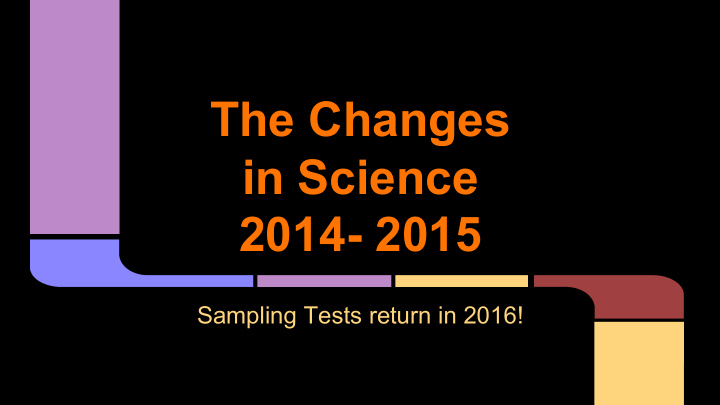



The Changes in Science 2014- 2015 Sampling Tests return in 2016!
The principal focus of science teaching in key stage 1 is to enable pupils to experience and observe phenomena.’ During years 1 and 2, pupils should be taught to use the following practical scientific methods, process and skills.’ In order to do this they must: 1) ask simple questions and recognising that they can be answered in different ways. 2) observe closely, using simple equipment 3) perform simple tests 4) identify and classify 5) use their observations and ideas to suggest answers to questions Cognitive domain The cognitive domain seeks to make the thinking skills and intellectual processes required for the key stage 2 science sampling test explicit. Each question will be rated against the strands of the cognitive domain listed in tables 7 and 8 below. The cognitive domain will be used during test development to ensure comparability of demand as well as difficulty for tests of successive years. The cognitive domain for science was based on Bloom’s Cognitive Domain2 . This provides a broad framework which the facts, processes and interpretations that need to be tested in science can be matched to. It allows broad testing of different aspects of children’s scientific knowledge, including basic recall (eg of terminology); interpretation of data; and formulation of original responses to novel scenarios which draw on a broad scientific knowledge and skills base. Items have been grouped as follows: • Items which assess factual knowledge (Knowledge and Comprehension) • Items that require children to deduce an answer from presented data, or produce an answer based on use of scientific knowledge in a familiar or straightforward context (Application and Analysis) • Items that require children to select which knowledge is appropriate, and possibly produce an answer that is original and tailored to a specific scenario (Synthesis and Evaluation)
KS1 / KS2 The science key stage 1/2 curriculum consists of: Sc1 Scientific enquiry Sc2 Life processes and living things Sc3 Materials and their properties Sc4 Physical processes Breadth of study
Sc1 Scientific enquiry Ideas and evidence in science 1. Pupils should be taught that it is important to collect evidence by making observations and measurements when trying to answer a question. Investigative skills 2. Pupils should be taught to: Planning a. ask questions [for example, 'How?', 'Why?', 'What will happen if ... ?'] and decide how they might find answers to them b. use first-hand experience and simple information sources to answer questions c. think about what might happen before deciding what to do d. recognise when a test or comparison is unfair
Sc1 Scientific enquiry Obtaining and presenting evidence e. follow simple instructions to control the risks to themselves and to others f. explore, using the senses of sight, hearing, smell, touch and taste as appropriate, and make and record observations and measurements g. communicate what happened in a variety of ways, including using ICT [for example, in speech and writing, by drawings, tables, block graphs and pictograms] Considering evidence and evaluating h. make simple comparisons [for example, hand span, shoe size] and identify simple patterns or associations i. compare what happened with what they expected would happen, and try to explain it, drawing on their knowledge and understanding j. review their work and explain what they did to others.
Can we demonstrate the 4 strands of Science? A key area of focus for 2015-2016 will be to ensure that the 4 strands of the Science curriculum are very clearly evidenced in the book or within online folders. We will also be looking for cross curricular work - Writing (English) and measurements / graphing (Maths)
Targets Do the children know what is expected of them? In order for children to be able to succeed it is imperative that we ensure that they know what their targets are - in terms that they can understand. These targets will be evaluated on their school report.
Tick Date I can Science – Year 6 Working Plan different kinds of fair experiments. scientifica lly Recognise why controlling variables is important and explain how I do this in my experiments. Take accurate measurements using scientific equipment. Take repeated measurements when appropriate. Record data using: Labelled scientific diagrams. Classification keys. Tables. Bar charts. Line charts. Draw conclusions from my results and describe causal relationships in results. Present my findings in a written report with an introduction, conclusion and results. Present my findings in an oral presentation. Identify scientific evidence that has been used to support or refute ideas or arguments.
Exciting News!! We have been graciously allowed access to…...
The Lyndhurst Part Nature Reserve 2.3 hectares of protected land that runs along the old Highgate to Edgware line between Deans Lane and Bunns Lane. The area is partially wooded with areas of rough pasture and wild flowers. It also has a large number of slow worms…..
The Strange and Wonderful Species SLOW WORMS 6 SPOTTED BURNET MOTH
Fall Mill Hill Old Railway Nature Reserve is a 2.3 hectare
FYI A group of year 6 students were the first from Woodcroft to explore the site. We saw numerous species of moths, trees, flowers and more than 10 slow worms. Photographs can be found on the school website. This is a lockable / gated site where nature is actively being protected in the local area. The historical significance of the railroad line is a bonus for year groups studying the local area from a historical perspective.
We saw 15 slow worms!!
Recommend
More recommend